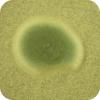Description
Penicillium digitatum is a plant pathogen. It is a common postharvest fungus disease of citrus called green mold.
The name Penicillium comes from penicillus, which means brush, and this is based on the brush-like appearance of the fruiting structures under the microscope. Penicillium typically produces these brush-like heads. The stalk is called the conidiophore. The conidiophore branches at the tip. At the end of each branchlet is a cluster of spore-producing cells called phialides. A chain of spores is formed from the tip of each phialide. The spore is called a conidium or phialsopore. The spores in Penicillium often contain blue or green pigments which give the colonies on foods and feeds their characteristic colour. It is the spores in the blue cheese that give the colour to the cheese. The spores are only a few micrometres in diameter.
(Text and image from Wikipedia, the free encyclopaedia.)
Ensembl Genomes provides access to two strains of this species:

